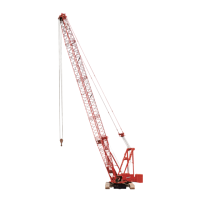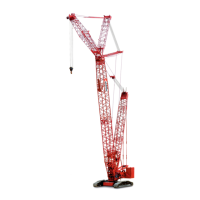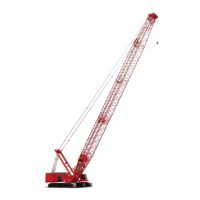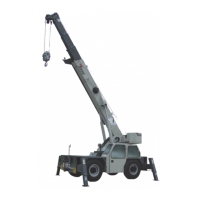INTRODUCTION 999 SERVICE/MAINTENANCE MANUAL
1-14
Published 05-16-17, Control # 233-03
NOTE: The boom angle sender and luffing jib sender
(optional) system faults are part of the boom top
electrical system. Inputs from the boom top
electrical system are sent to the PC and are
internal to the PC program. See RIN (Remote Input
Node) Display Readings in 999 Operator Manual
for boom top electrical system instructions.
Operating Faults and Limit Switches
See Figure 1-8
When operating, all limit switches are closed, sending input
signals to the PC. If a limit switch is tripped, the PC sends an
output signal to pump EDC and brake solenoid. The pump
de-strokes and brake solenoid valve shifts to spring-apply
brake. Move control in the opposite direction away from limit
to correct the problem.
Limit bypass key switch (1) allows crane to be operated
beyond the limits for crane setup or maintenance only. See
Bypassable Limit Identification, Table 3-1 in Section 3 of 999
Operator Manual.
The PC monitors crane systems and enables an alert (3) if
any limit switch is open or any programmed limit is reached.
To identify and display operating limit, use digital display
screen and scroll switch (4) to scroll display up or down.
When an operating limit is enabled, the PC displays one or
more of the following messages:
BLOCK UP – Load drums stops hoisting and boom/luffing jib
hoist stops lowering.
MAXIMUM DOWN – Stops boom from lowering; limit usually
set at 0°. Stops luffing jib from lowering when boom-to-luffing
jib angle is 60°.
MAX UP-1 – Stops boom at 83° or if equipped with luffing jib
at 88°. Stops luffing jib when boom-to-luffing jib angle is 168°.
MAX UP-2 – Stops luffing jib when boom-to-luffing jib angle
is 170°. Limit can be bypassed only when boom is below 50°.
CONFIRM MODE – All functions inoperable until an
operating mode is selected and confirmed.
MAX BAIL – Stops load drum when a preset length of wire
rope is spooled onto drum.
MIN BAIL – Stops load drum when there are 3 to 4 wraps of
wire rope remaining on drum.
GANTRY DOWN – Boom hoist inoperable in both directions
if gantry is down when mast angle is 120° or more.
JIB BELOW HORIZONTAL – Luffing jib operable. See
Capacity Chart Manual for luffing jib minimum operating
angles.
RATED CAPACITY – All load drums stop hoisting and boom/
luffing jib stop lowering.
MAST TOO FAR FWD – Boom hoist inoperable in lowering
direction (occurs if mast is below 175°).
MAST SYSTEM – Boom hoist inoperable in both directions.
FUNCTION IS PARKED – Function inoperable because it is
parked.
NOTE: The block up, maximum down, maximum up-1,
maximum up-2, and jib below horizontal (optional)
limits are part of the boom top electrical system.
Inputs from the boom top electrical system are sent
to the PC and are internal to the PC program. See
RIN (Remote Input Node) Display Readings in 999
Operator Manual for instructions on boom top
electrical system.
Brake and Drum Pawl Application/Release
The load drums brakes and boom hoist drum brakes are
spring-applied and hydraulically released. The operator
enables brake/pawl operation by placing selected brake
switch in off - park position. The load drum pawl or boom
hoist drum pawl is disengage.
The PC controls release of selected brake with control
handle movement. When PC enables the selected brake
release solenoid, the brake valve shifts to block tank port and
supplies pressurized fluid to hydraulically release brake.
With a up command, the PC does not release drum brake
until pressure memory holding pressure is reached to hold
the load, as determined by pressure senders. In a down
command, the PC sends an output signal to pump EDC to tilt
swashplate momentarily in up direction, opposite to the
selected load drum handle command. The PC then sends an
output signal to release brake when pressure memory
holding pressure is reached.
As selected drum control handle nears neutral position, the
PC compensates for hydraulic system leakage from
changing load weight or changing engine speed. The PC
sends an output signal to adjust swashplate in the up
direction until load is supported and pressure memory is
stored.
When drum control handle command is off for a preset time,
the PC sends a output signal to disable the selected brake
release solenoid, brake release solenoid valve shifts to block
pressurized flow to brake. This opens a line to tank for brake
hydraulic fluid and brake spring-applies. Placing selected
brake switch in on - park position disables brake/pawl
operation.
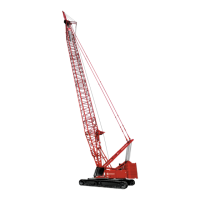
